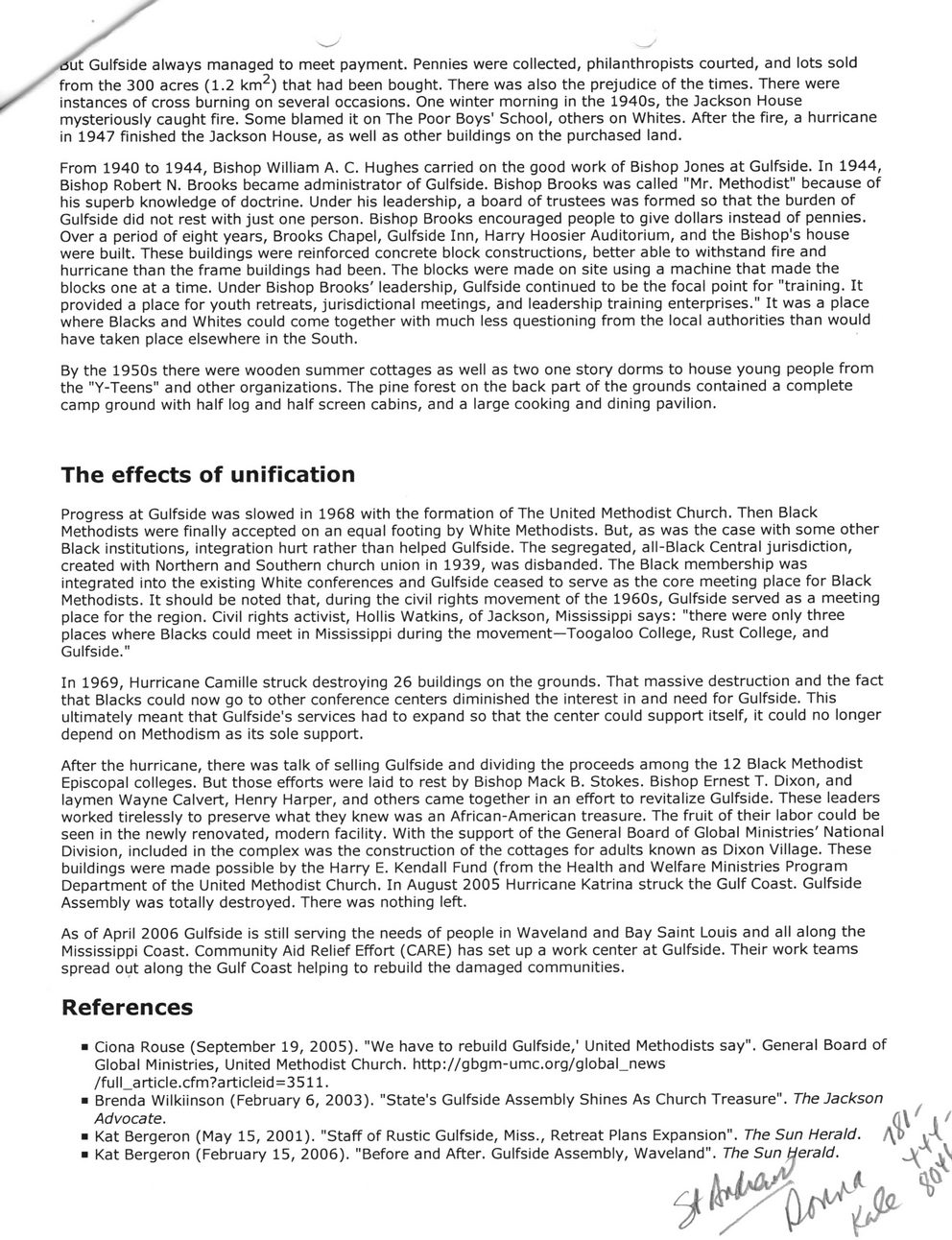This text was obtained via automated optical character recognition.
It has not been edited and may therefore contain several errors.
ut Gulfside always managed to meet payment. Pennies were collected, philanthropists courted, and lots sold from the 300 acres (1.2 km2) that had been bought. There was also the prejudice of the times. There were instances of cross burning on several occasions. One winter morning in the 1940s, the Jackson House mysteriously caught fire. Some blamed it on The Poor Boys' School, others on Whites. After the fire, a hurricane in 1947 finished the Jackson House, as well as other buildings on the purchased land. From 1940 to 1944, Bishop William A. C. Hughes carried on the good work of Bishop Jones at Gulfside. In 1944, Bishop Robert N. Brooks became administrator of Gulfside. Bishop Brooks was called "Mr. Methodist" because of his superb knowledge of doctrine. Under his leadership, a board of trustees was formed so that the burden of Gulfside did not rest with just one person. Bishop Brooks encouraged people to give dollars instead of pennies. Over a period of eight years, Brooks Chapel, Gulfside Inn, Harry Hoosier Auditorium, and the Bishop's house were built. These buildings were reinforced concrete block constructions, better able to withstand fire and hurricane than the frame buildings had been. The blocks were made on site using a machine that made the blocks one at a time. Under Bishop Brooks' leadership, Gulfside continued to be the focal point for "training. It provided a place for youth retreats, jurisdictional meetings, and leadership training enterprises." It was a place where Blacks and Whites could come together with much less questioning from the local authorities than would have taken place elsewhere in the South. By the 1950s there were wooden summer cottages as well as two one story dorms to house young people from the "Y-Teens" and other organizations. The pine forest on the back part of the grounds contained a complete camp ground with half log and half screen cabins, and a large cooking and dining pavilion. The effects of unification Progress at Gulfside was slowed in 1968 with the formation of The United Methodist Church. Then Black Methodists were finally accepted on an equal footing by White Methodists. But, as was the case with some other Black institutions, integration hurt rather than helped Gulfside. The segregated, all-Black Central jurisdiction, created with Northern and Southern church union in 1939, was disbanded. The Black membership was integrated into the existing White conferences and Gulfside ceased to serve as the core meeting place for Black Methodists. It should be noted that, during the civil rights movement of the 1960s, Gulfside served as a meeting place for the region. Civil rights activist, Hollis Watkins, of Jackson, Mississippi says: "there were only three places where Blacks could meet in Mississippi during the movement—Toogaloo College, Rust College, and Gulfside." In 1969, Hurricane Camille struck destroying 26 buildings on the grounds. That massive destruction and the fact that Blacks could now go to other conference centers diminished the interest in and need for Gulfside. This ultimately meant that Gulfside's services had to expand so that the center could support itself, it could no longer depend on Methodism as its sole support. After the hurricane, there was talk of selling Gulfside and dividing the proceeds among the 12 Black Methodist Episcopal colleges. But those efforts were laid to rest by Bishop Mack B. Stokes. Bishop Ernest T. Dixon, and laymen Wayne Calvert, Henry Harper, and others came together in an effort to revitalize Gulfside. These leaders worked tirelessly to preserve what they knew was an African-American treasure. The fruit of their labor could be seen in the newly renovated, modern facility. With the support of the General Board of Global Ministries' National Division, included in the complex was the construction of the cottages for adults known as Dixon Village. These buildings were made possible by the Harry E. Kendall Fund (from the Health and Welfare Ministries Program Department of the United Methodist Church. In August 2005 Hurricane Katrina struck the Gulf Coast. Gulfside Assembly was totally destroyed. There was nothing left. As of April 2006 Gulfside is still serving the needs of people in Waveland and Bay Saint Louis and all along the Mississippi Coast. Community Aid Relief Effort (CARE) has set up a work center at Gulfside. Their work teams spread out along the Gulf Coast helping to rebuild the damaged communities. References ■ Ciona Rouse (September 19, 2005). "We have to rebuild Gulfside,1 United Methodists say". General Board of Global Ministries, United Methodist Church, http://gbgm-umc.org/global_news /full_article.cfm?articleid=3511. ■ Brenda Wilkiinson (February 6, 2003). "State's Gulfside Assembly Shines As Church Treasure". The Jackson Advocate. (U ■ Kat Bergeron (May 15, 2001). "Staff of Rustic Gulfside, Miss., Retreat Plans Expansion". The Sun Herald. t\0 Kat Bergeron (February 15, 2006). "Before and After. Gulfside Assembly, Waveland". The Sun Herald. J I I". The Sun H

Gulfside Methodist Assembly Gulfside-Methodist-history-(2)